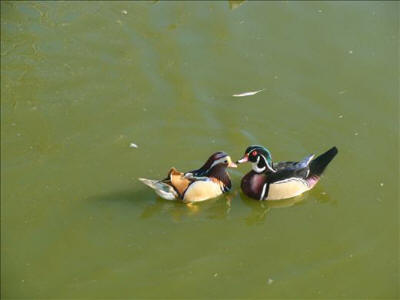Classification
General Classification
Domain:
Eukarya (All organisms whose cell(s) contain organelles.)Kingdom: Animalia (All heterotrophic organisms that are motile at some stage in life.)
Phylum: Chordata (Animals containing a dorsal notochord, or spinal chord.)
Class: Aves (All of the birds. Birds are
warm-blooded animals possessing an elongated neck, a pair of wings and reproducing
sexually through laying amniotic eggs. These are animals some believe to
have been derived from reptiles.)
Order: Anseriformes (Limited to birds including all of the geese, swans, ducks, and screamers. All of these contain webbed-feet and live in and around water.)
Family: Anatidae (Includes all of the geese, swans and ducks. These are all of the duck-like organisms, generally found on the surface of the water.)
Subfamily: Anatinae
(All of the "puddle ducks," known to feed exclusively in shallow water
and capable of taking flight without a "running start.")
Genus:
Aix
( Consists of only the North American Wood Duck and the
Mandarin Duck, which is native to eastern Asia. This genus is characterized by
specific morphological traits such as drake color patterns as well as a tendency to perch and nest in
trees.)
Species: Aix sponsa (The Wood Duck, a duck native to North America, with particular drake color patterns including a green head and red eye.)

The phylogenetic tree shown above does not represent evolutionary history, but is merely a grouping of related families, subfamilies, genera, and species. The classification of the wood duck is based primarily on morphological traits, but geography plays a large part as well. The shared morphologies of the order Anseriformes (waterfowl) seem intrinsically related to their shared habitats, so no one form of taxonomy was used when grouping them.
Tracing the Wood Duck’s phylogeny we see that it emerges from the genus Aix, which is shared only with the Mandarin Duck (Aix galericulata). The Mandarin, native of eastern Asia, has only recently made a home for itself in North America. Both species are known to nest in trees, and the drake of each species has distinct color patterns on its head, wings, and body.
Cladistic Information
For an alternative look at the Wood Duck's classification we can look into mitochondrial DNA sequencing. Based on these sequences, a different chart can be developed, based on more than simply morphological traits. By using the similarities in sequences found, we can in turn justify how related on organism is to another.
Below, notice how the branching becomes more complicated when reaching the genus level. Concentrating on the Wood Duck, highlighted in red, we see that many of the ducks most closely related to it share behavioral, as well as morphological similarities. Some of these including having drakes that have brightly colored feathers, and the habit of nesting in trees.

Next, learn about the Wood Duck's habitat.
Questions or comments? Email me at larson.chri@students.uwlax.edu